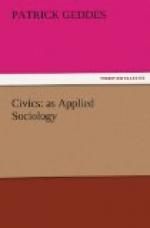Similarly for the pasture, the forest. Every tourist in this country is struck by the contrast of Swiss towns and cities with our own, and notes [Page: 62] too that on the Swiss pasture he finds a horde of cattle, while in Scotland or Yorkshire he left a flock of sheep. And not only the tourist, but the historian or the economist too often fail to see how Galashiels or Bradford are developments of the wool hamlet, now familiar to many in R.L. Stevenson’s native Swanston. Again, not only Swiss wealth, but Swiss character and institutions, go back essentially to the high pasture and the well-filled byre. That this rich Swiss cow-pasture rests on limestone, and the poor Scottish sheep-grazing upon comparatively unmouldering and impermeable gneiss, is no mere matter of geologist’s detail; it affords in each case the literal and concrete foundation-stone of the subsequent evolution of each region and population, and this not only in material and economic development, but even in higher and subtler outcomes, aesthetic, intellectual and moral.[4] It is for such reasons that one must labour and re-labour this geographic and determinist aspect of sociology, and this for no merely scientific reason, but also for practical ones. Nowhere perhaps have more good and generous souls considered how to better the condition of their people than in Swiss, or Irish, or Scottish valleys; yet it is one main reason of the continual failure of all such movements, and of such minds in the wider world as well, that they do not first acquaint themselves with the realities of nature and labour sufficiently to appreciate that the fundamental—I do not say the supreme—question is: what can be got out of limestone, and what can be got out of gneiss? Hence the rare educative value of such a concrete sociological diagram and model as was the Swiss Village at the Paris Exposition of 1900, for here geographic and economic knowledge and insight were expressed with artistic skill and sympathy as perhaps never before. Only as similar object-lessons are worked out for other countries, can we adequately learn, much less popularly teach, how from nature comes “rustics,” and from this comes civics. But civics and rustics make up the field of politics; they are the concrete of which politics become the abstract—commonly the too remotely abstract.




